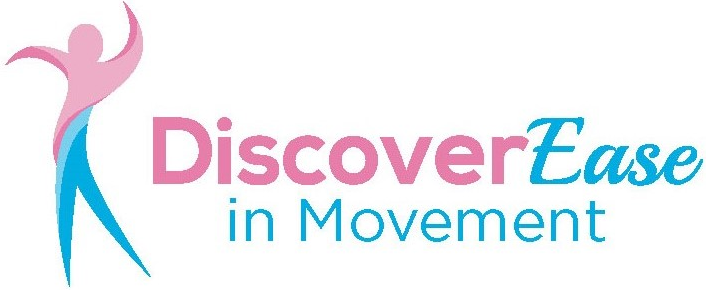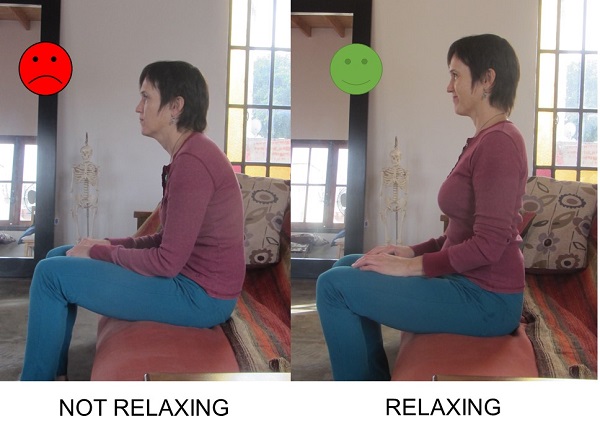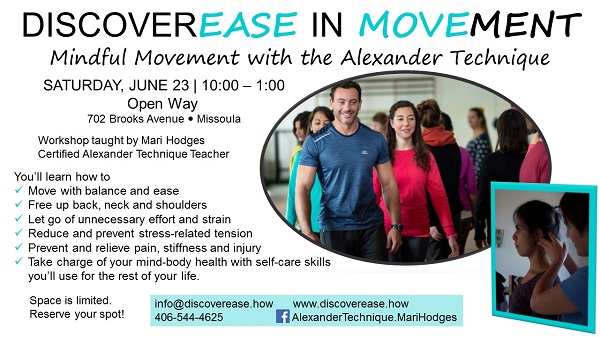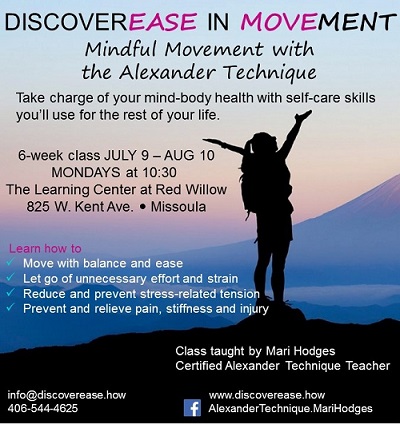Pain and stiffness often come from using the body in a way that is contrary to its design. For example, many people hold up body parts with muscles that aren’t meant to do that job.
Here are three ways you may be “holding yourself up” unnecessarily and one way to help you stop. (If you’re really anxious, just scroll down to the steps!)
1. Forward head posture
“Forward head posture” or “text neck” is definitely one of those uses of the body that are contrary to the body’s design. Forward head posture actually usually means pushing the chin forward and tipping the top of the head back. This not only compresses the spine and everything else that passes through the neck, it also puts a tremendous load of weight on muscles and joints that aren’t designed to hold up a weight out there in front all the time.
2. Relaxing
Another insidious habit of holding up body weight actually happens during what’s supposed to be relaxing. The problem with “relaxing” is that when most people do it, they’re actually pulling themselves downward. This often happens because of the mistaken notion that gravity pulls us down. If your chest collapses downward and your back pushes back when you relax, you’re working harder than you think you are. Muscles are working overtime to hold you up in a collapsed position and to get air into your lungs.
3. Stress response
Another way you could be using your body in a way it’s not designed to be used is by activating your flight-fight-freeze response. It can be activated by stress and by pain. “Great,” you say, “where does that leave me?” Well, it’s helpful to understand why.
When you run into a bear, your flight-fight-freeze response goes into action, activating long muscles (like your trapezius or hamstrings, for example). These muscles are really good at saving your hide in the short term. When they are activated long term, however, they contract and tighten, making you stiff. Even worse, though, that same stress response deactivates your postural support muscles, like the short muscles between your vertebras, since they’re not required for your immediate survival. This misuse of muscles and joints, like the others, leads to a cycle of stiffness and pain.
What to do about it
The tricky thing about forward head posture, collapsed relaxing and tensing muscles due to stress or pain is that you probably don’t notice you’re doing it most of the time. That’s the nature of habit: it feels natural to us.
Here are 3 steps you can start to do today that will put you on the road to using your body in a healthier way to break free of the cycle of pain and stiffness.
- Stop
- Check in with your self
- Stop
- Release upward and outward
Ok, I realize that’s four, but 1 and 3 are the same. Let me explain.
1. Stop
The first thing, even though it might seem silly, is to just stop. Stop what you’re doing right now, and at any time you remember this article. (Below I’ll describe a practical way to do that every day.) Stopping doesn’t mean holding yourself still – that’s actually doing something. If you truly stop, overacting muscles will begin to release.
2. Check in with your self: Ask your self where you can do less. And if you find something, like shoulders hunched forward or your head pulled down, or hands gripping, that’s when you repeat step 1!
3. Stop! Do nothing! Do not react to what you found! The reason for this is that we are generally wired to react to what we perceive as negative by doing something, and that something usually involves extra muscular tension – which is usually what got us into the problem in the first place! So enjoy your freedom to just notice and not try to fix anything.
4. Now, invite your self to open upwards and outwards by releasing in those directions. Note that I didn’t say straighten up or push your shoulders back. It also doesn’t mean collapsing. Invite your spine to lengthen and your back and chest to widen as your head balances easily on top of your spine.
I’ll be teaching group classes and private lessons and conducting company in-house trainings in Montana this summer, June through August. You can see the scheduled DiscoverEase in Movement class information below. Contact me at info@discoverease.how to register, schedule a private lesson or find out more about holding postural and movement training at your workplace. And if getting there is a challenge, take an online class!
Please feel free to share this article with someone you think might be interested!
Wishing you ease and wholeness,
Mari




Recent Comments